Endemic Birds Of The Dominican Republic And Punta Cana
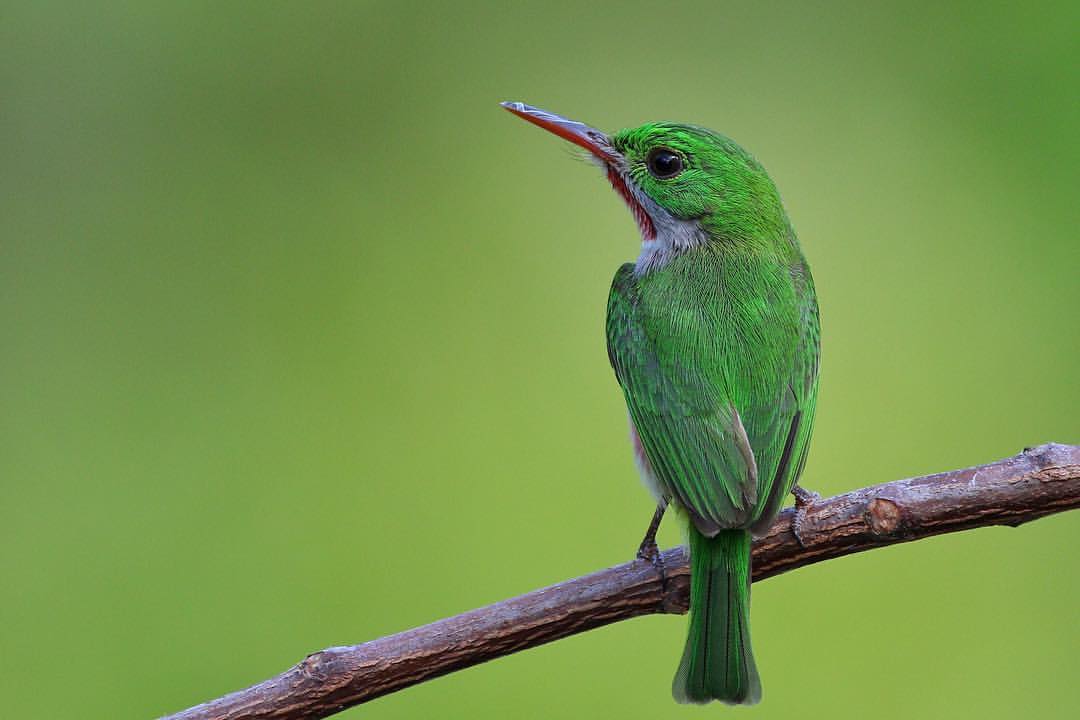
The Dominican Republic has wide biodiversity of bird species. Among the 31 endemic species in the Hispaniola and adjacent islands, 30 can be observed in the Dominican Republic.
Among the endemic ones, so called because they are unique to the Dominican Republic, are the Cigua Palmera, Pájaro Bobo, Gavilán, Perdiz Coquito Blanco, Perico, Cotorra, Cúa, Cara Ceniza Owl, Zumbador Esmeralda, Barrancolí, Carpintero de Sierra and Maroíta, among others.
In addition, there are the migratory birds, which come from other countries especially in the month of September, who stay for three months and then return to their destination.
They come from the United States, Canada and other countries, and travel when the winter cold begins, in search of warmth, shelter and food.
The Dominican Republic is rich in birding. A good option is the Sierra de Bahoruco National Park, only 4 or 5 hours from Santo Domingo.
There the visitor has the option to stay in the Villa Barrancolí, located only 10 kilometers from the National Park where bird watching is located.
This tour must be done in the morning, at 6:00, which is the time when the birds are leaving.
In the Dominican Republic there are 32 endemic birds. Of these, there are 29 that can be observed in the Sierra de Bahoruco National Park.
Contents
Hispaniola Hawk
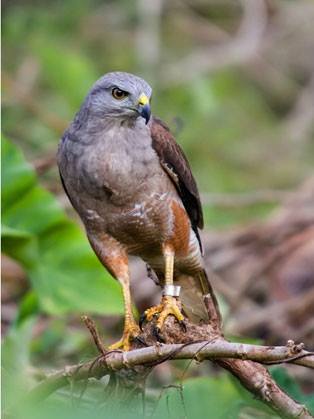
Hispaniola Hawk (Buteo ridgwayi). One of the most endangered species of birds of prey in the Americas, it used to inhabit the humid forests, savannas and sparsely vegetated mountains of the Hispaniola.
But now its only known population resides within the Neotropical forests of Los Haitises National Park and certain undisturbed wooded areas in the northeast of the Dominican Republic.
It feeds on lizards, snakes, rats, bats, toads, insects and small birds. On rare occasions, it attacks small poultry. The Sparrowhawk has an important role in our ecosystem, as it serves as biological control of pests and rodents that can transfer diseases or affect agriculture.
It nests in the tallest trees, between 20 to 60 feet above the ground. Nest construction occurs between the months of January and March, while egg-laying is between February and April.
Lay 2 to 3 eggs. Males are known to participate in incubation and both adults care for the chicks until they fly.
Barrancolí (Todus subulatus)
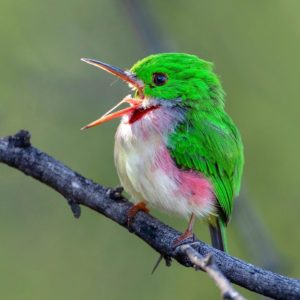
This small, stubby bird has a voracious appetite and can consume more than a third of its weight in insects per day. It inhabits low-lying areas, but is most common in vegetated gullies, pine forests, coffee plantations, mangroves and dry limestone forests.
This little bird has been compared to “an emerald and ruby jewel.” With its bright green color, red throat, whitish chest, pink sides and chubby bearing, the barrancolí has a very nice air that everyone likes.
Its bright colors made the first naturalists who visited the island confuse it at first sight with a tiny parrot.
Bobo bird (Saurothera longirostis)
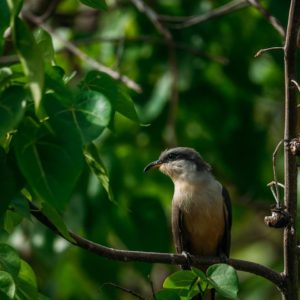
It is one of the most common birds on the island of Hispaniola since it lives in all types of tropical forests.
Its song is quite persistent and unique, especially during the breeding season, Adults of this species can be 16 to 18 inches long, they have a slender body and a long tail with white feather tips, the head and upperparts are gray, while their breasts are a paler gray.
They have a reddish-brown spot on the wing. Distinguished by their straight, slender beaks and red circle around the eye, they feed on lizards and large insects, and their song is quite persistent and unique, especially during the mating season (March to June).
Parrot (Psittacara chloroptera).
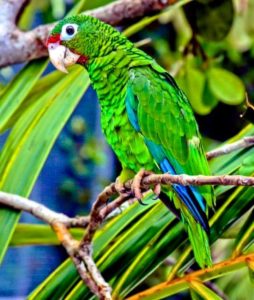
Inhabits dry forests and humid forests in lowland and mountain areas. There are growing populations in urban areas, especially the green areas of Santo Domingo. It is a very social bird, as they generally fly in pairs or form large flocks that can exceed several dozen individuals.
Bahoruco chirp (Calyptophilus tertius)
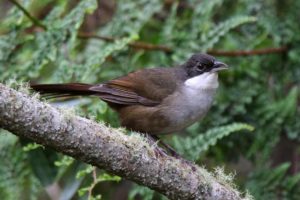
It lives in the humid forests or areas of dense vegetation in the mountainous areas of the Bahuruco Mountain Range in the Dominican Republic, and the Massif de la Hotte and Massif de la Selle in Haiti. It is distinguished by its melodious song of whistles and intense buzzing.
Cordillera Central chirp (Calyptophilus frugivorus). It lives in the humid forests or areas of dense vegetation in the mountainous areas of the Sierra de Neiba and the Cordillera Central in the Dominican Republic, and the Ile de la Gonave in Haiti. It uses its legs to find its food as insects and seeds under the dry leaves on the ground.
Cua (Hyetornis rufigularis)
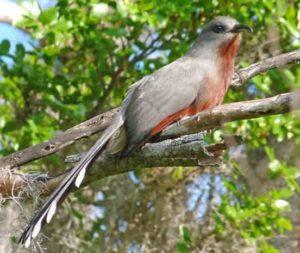
This species is threatened by habitat loss and hunting for medicinal purposes, as there is a false belief that cúa meat can cure arthritis and increase appetite in children.
In its reproduction, the cua, lays two white eggs, in nests located in bushes or in dense foliage, between March and June of each year, according to consulted references. Adult individuals of this species can measure up to 50 cm.
Ashy-faced Owl (Tyto glaucops)
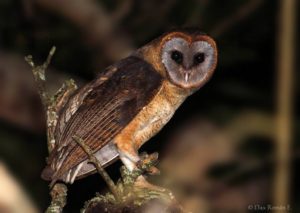
Its natural habitat is dry scrub and grassland with trees, but it is also common in rural urban areas. They feed mainly on rodents and small birds, but also hunt lizards and frogs their natural habitat is dry bushes and meadows with trees, but they are also common in rural urban areas.
They reproduce between January and June, build their nests in the natural crevices of trees, caves, attics, barns or any other abandoned building, and lay between 4 and 7 eggs.
This species is threatened by the loss of its habitat, as they are more dependent on forests than other owl species.
Woodpecker (Melanerpes striatus).
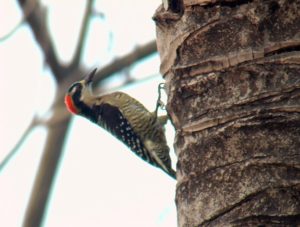
It lives in almost every kind of forest on our island. Unlike most woodpecker species, this is a very social species, as they form large colonies of up to 20 pairs to protect a nest or a tree.
The plumage of most woodpeckers is dominated by bright and strong colors that depend in part on the area they live in. Many specimens have some yellow and pink while others have red and beige parts on their heads and bellies.
They have strong beaks, which serve them to drill and drum the trees and make the characteristic noise by which they are immediately recognized. For example, the black woodpecker can drill up to 15 cm into the wood or tree looking for food.
Its tongue is thin and pointed and has a rough surface so that it can take out the food it is going to eat or store.
Woodpecker (Nesoctites micromegas). At first glance, this bird does not look like a woodpecker due to its small size and stubby body. It feeds mainly on insects, but also eats fruit.
Ciguas
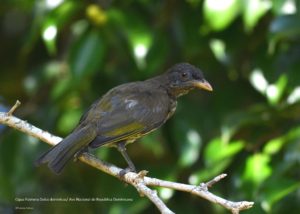
• Palm Cigua (Dulus dominicus). The national bird of the Dominican Republic inhabits almost every type of environment on our island from forests, fields and urban areas, but it is more common in places where there are royal palms. They build large communal nests with small branches, which resemble apartments.
• Ciguita Aliblanca (Xenoligea montana). It lives in humid forests and pine forests in areas of high elevation. It is most common in the Cordillera Central, Sierra de Bahoruco and Sierra de Neiba in the Dominican Republic, and the Massif de la Selle in Haiti.
• Ciguita Juliana (Vireo nanus). Its natural habitat is dry scrub and limestone mountain bases. It builds its cup-shaped nest in shrubs and low vegetation.
• Canarian Cigua (Icterus dominnicensis). Its striking plumage is mostly black, mixed with yellow on the shoulders, tail and sub-caudder coverings. It inhabits almost all types of forest on Hispaniola, but is more common in lowland rainforests and coastal forests where palms are present.
• Yellow Cigua (Spindalis dominicensis). It is most common in the Sierra de Bahoruco, Sierra de Neiba and the Central, Northern and Eastern Cordilleras in the Dominican Republic. This short-billed bird is very distinctive due to the differences in plumage between the male and female of its species.
• Ciguita green tail (Microligea palustris). Inhabits dry forests and shrublands, and is common in the lowlands and highlands in the western territory of the Dominican Republic, and the Massif de la Selle in Haiti.
Canarian (Carduelis dominnicensis)
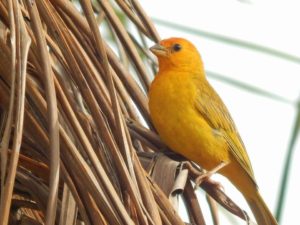
It lives in tropical forests, pine forests and grass clearings in mountainous or elevated areas.
Like most species of the family Fringillidae, males have more colorful plumage than females. Like other finches (family Fringillidae), this beautiful, brightly colored loofah has a strong, tapered beak adapted to eat seeds. Although only 11 centimeters long, this tiny bird has “a lot of personality.”
Its name of canary in the Dominican Republic possibly originated from its resemblance to the wild canary (Serinus canaria), endemic to the Canary Islands, Azores and Madeira, which has been domesticated for centuries in Europe.
Pico Cruzado (Loxia megaplaga).
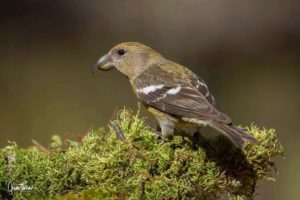
It is characterized by its conical peak that is used to extract the seeds from the pine cones of the creole pines. It inhabits pine forests in the Bahoruco and Central Mountain ranges in the Dominican Republic, and the Massif de la Selle and Massif de la Hotte in Haiti.
The adults of this species are between 15 and 16 centimeters long. Males are dark brown with a pale red wash all over their body. The red colour is more intense on the head, the upper part of the back and the chest. Females are also dark brown, but have a yellowish wash on the front, fine streaks on the chest and a yellow rump.
It is characterized by its conical beak which is used to extract the seeds from the pine cones of the creole pines.
Papagayo (Priotelus roseigster)
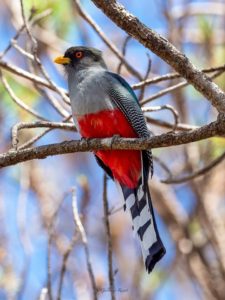
The parrot is one of the most colorful and beautiful birds in the Dominican Republic. The adults measure approximately between 27 and 30 centimeters in length, the upper part of the parrot is bright green, while its throat, chin and chest are gray.
Its belly is red and its long tail is dark blue with white markings on the bottom. Males have thin black and white bars on their wings, while females lack the white bars and the red colour on their belly is less intense.
It feeds on fruits, insects and small reptiles. They breed between the months of March and July.
They build their nests in the natural crevices of trees or in holes abandoned by carpenters. They lay two to four pale green eggs.
It is most common in the Sierra de Bahoruco, Sierra de Neiba, Cordillera Central and Codillera Septentrional in the Dominican Republic, and the Massif de la Hotte in Haiti.
Raven (Corvus leocognaphalus)
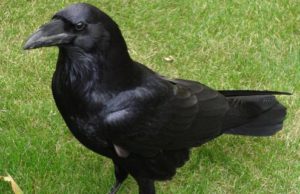
This robust-bodied bird with a large beak is the largest of the four species of ravens that inhabit the Caribbean. It has a great variety of vocalizations, similar to the common raven (Corvus corax). Also, it can imitate sounds from its environment including human language.
White Coquito Partridge (Geotrygon leucometopia).
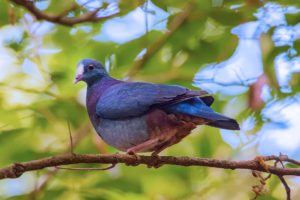
During the 20th century, populations of these birds have declined due to illegal hunting and logging in elevated areas. There are reports of small populations in the Cordillera Central and Sierra de Bahoruco in the Dominican Republic, and in the Massif du Nord in Haiti.
Torico (Siphonorhis brewsteri)
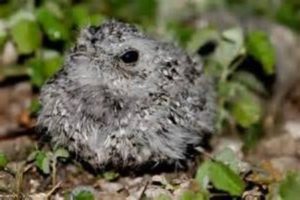
It’s a bird of nocturnal habits. Its flight is erratic like that of a night butterfly. It feeds on insects during flight. They inhabit the dry forests and semi-arid areas of our island.
Emerald Buzzer (Chlorostilbon swainsonii)
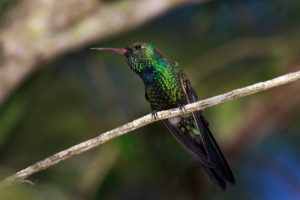
It lives in the humid forests in the mountainous areas and hills of the interior of our island, but it is more common in the forests of the Central Mountain Range and the Bahoruco Mountain Range in the Dominican Republic. They build their nests of moss and plant material in the lower parts of the trees or bushes.
Pitanguá (Caprimulgus eckmani).
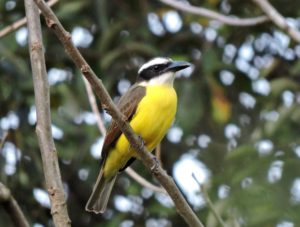
It is a bird of nocturnal habits. During the day, it rests hidden in the undergrowth near the ground. It feeds on insects during flight. It lives in the humid forests in the most western areas of our island.
Parrot (Amazona ventralis)

One of the most striking endemic bird species of Hispaniola, it inhabits a variety of wooded environments from arid palms to the humid forests in the mountains of our island. It feeds mainly on fruits and seeds, and usually forages in banana and corn plantations.
Maroita (Contopus hispaniolensis)
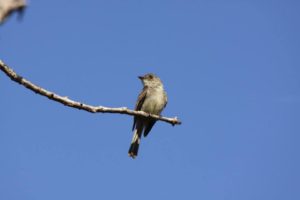
Endemic bird of the Dominican Republic, it lives in all types of forests on our island, but is most common in pine forests in mountainous areas, and is also often seen in plantations and orchards.


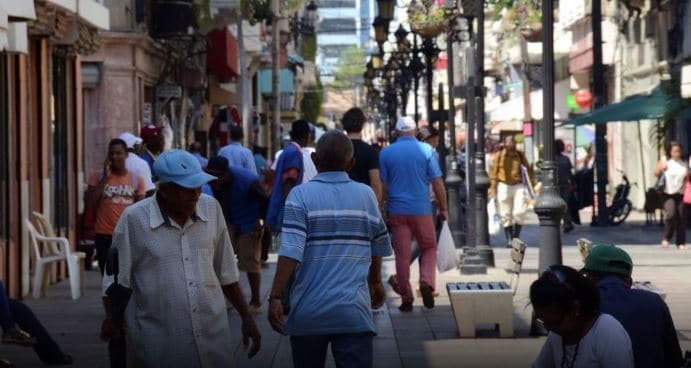
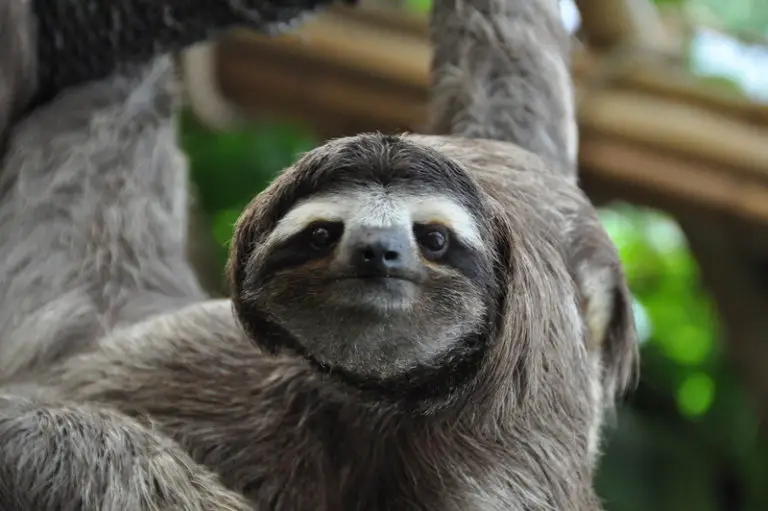
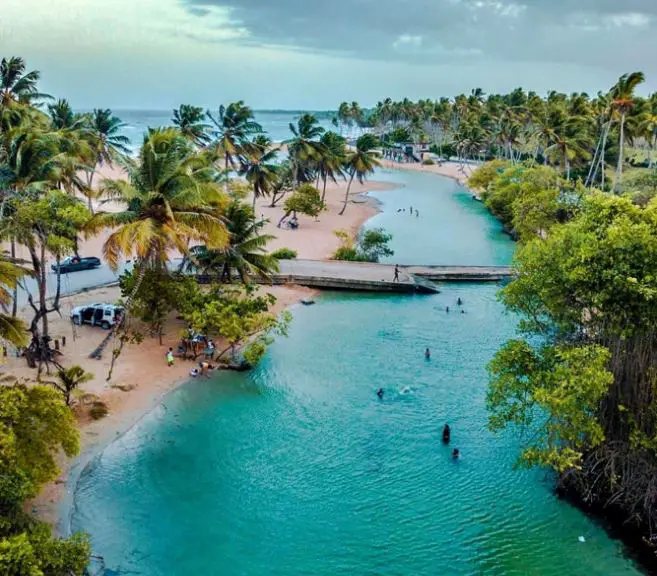
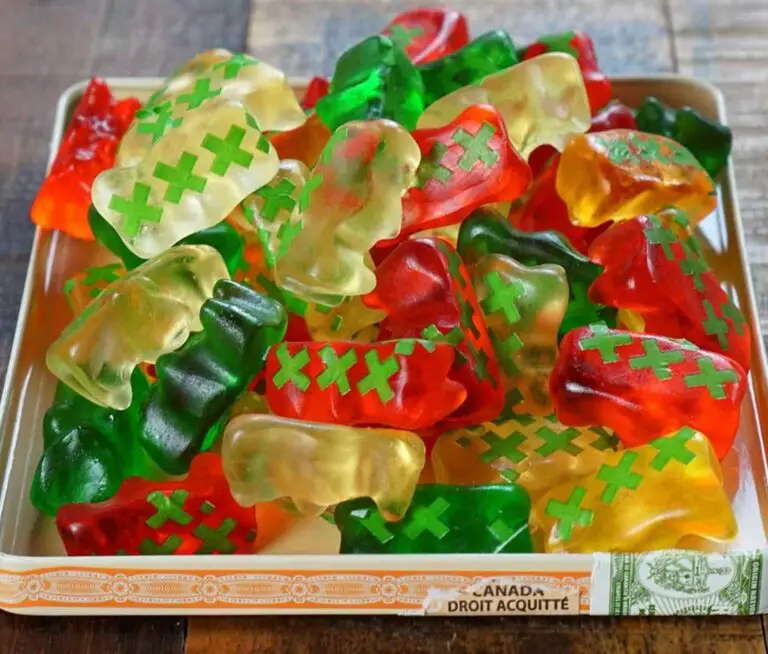

I enjoyed your article very much. I’ve taken up birdwatching as a hobby since the beginning of the pandemic. It’s become one of my favorite pastimes. I find birdwatching such a joyful way to commune with nature and reconnect with the same sense of discovery and curiosity for our environment that we once experienced as children. I’d like to know what Dominican native plants or trees I should consider planting in my garden in order to attract more native birds to my yard. Any suggestions?
Hi Caroline, from the times that I have designed landscapes I always include the coralillos, do you know them?
Coralillos are very inexpensive, easy to plant and attract hummingbirds, butterflies, bees and other small birds, it is a very ornamental plant.
There is also another ornamental plant similar to coralillo called Lantana.
Thank you so much for your reply, Elvis. I am not familiar with either plant but I will look them up and visit a garden center soon to start this project. Thank you!
Thanks for this – going to Punta Cana for honeymoon in 2 weeks – won’t be able to do too much proper birding but will have camera on me when out for walks etc so good to know what’s out there!